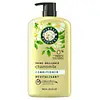What's inside
What's inside
 Key Ingredients
Key Ingredients

No key ingredients
 Benefits
Benefits

 Concerns
Concerns

 Ingredients Side-by-side
Ingredients Side-by-side

Water
Skin ConditioningCetyl Alcohol
EmollientParaffinum Liquidum
EmollientCetrimonium Chloride
AntimicrobialPanthenol
Skin ConditioningGlycerin
HumectantAnthemis Nobilis Flower Oil
MaskingPelargonium Graveolens Flower Oil
MaskingCalendula Officinalis Flower Extract
MaskingCeteareth-20
CleansingBis-PEG/PPG-20/20 Dimethicone
EmollientPhenoxyethanol
PreservativeCaprylyl Glycol
EmollientAllantoin
Skin ConditioningCitric Acid
BufferingPropylene Glycol
HumectantDisodium EDTA
Dipropylene Glycol
HumectantPantolactone
HumectantGlucose
HumectantLactic Acid
BufferingPentaerythrityl Tetra-Di-T-Butyl Hydroxyhydrocinnamate
AntioxidantWater, Cetyl Alcohol, Paraffinum Liquidum, Cetrimonium Chloride, Panthenol, Glycerin, Anthemis Nobilis Flower Oil, Pelargonium Graveolens Flower Oil, Calendula Officinalis Flower Extract, Ceteareth-20, Bis-PEG/PPG-20/20 Dimethicone, Phenoxyethanol, Caprylyl Glycol, Allantoin, Citric Acid, Propylene Glycol, Disodium EDTA, Dipropylene Glycol, Pantolactone, Glucose, Lactic Acid, Pentaerythrityl Tetra-Di-T-Butyl Hydroxyhydrocinnamate
Water
Skin ConditioningStearyl Alcohol
EmollientCetyl Alcohol
EmollientStearamidopropyl Dimethylamine
EmulsifyingPassiflora Incarnata Flower Extract
Skin ConditioningAnthemis Nobilis Flower Extract
MaskingAloe Barbadensis Leaf Juice
Skin ConditioningGlutamic Acid
HumectantParfum
MaskingBenzyl Alcohol
PerfumingBis-Aminopropyl Dimethicone
EDTA
Citric Acid
BufferingSodium Chloride
MaskingMethylchloroisothiazolinone
PreservativeMethylisothiazolinone
PreservativeCI 19140
Cosmetic ColorantCI 17200
Cosmetic ColorantWater, Stearyl Alcohol, Cetyl Alcohol, Stearamidopropyl Dimethylamine, Passiflora Incarnata Flower Extract, Anthemis Nobilis Flower Extract, Aloe Barbadensis Leaf Juice, Glutamic Acid, Parfum, Benzyl Alcohol, Bis-Aminopropyl Dimethicone, EDTA, Citric Acid, Sodium Chloride, Methylchloroisothiazolinone, Methylisothiazolinone, CI 19140, CI 17200
Ingredients Explained
These ingredients are found in both products.
Ingredients higher up in an ingredient list are typically present in a larger amount.
Cetyl Alcohol is a fatty alcohol. Fatty Alcohols are most often used as an emollient or to thicken a product.
Its main roles are:
Though it has "alcohol" in the name, it is not related to denatured alcohol or ethyl alcohol.
The FDA allows products labeled "alcohol-free" to have fatty alcohols.
Learn more about Cetyl AlcoholCitric Acid is an alpha hydroxy acid (AHA) naturally found in citrus fruits like oranges, lemons, and limes.
Like other AHAs, citric acid can exfoliate skin by breaking down the bonds that hold dead skin cells together. This helps reveal smoother and brighter skin underneath.
However, this exfoliating effect only happens at high concentrations (20%) which can be hard to find in cosmetic products.
Due to this, citric acid is usually included in small amounts as a pH adjuster. This helps keep products slightly more acidic and compatible with skin's natural pH.
In skincare formulas, citric acid can:
While it can provide some skin benefits, research shows lactic acid and glycolic acid are generally more effective and less irritating exfoliants.
Most citric acid used in skincare today is made by fermenting sugars (usually from molasses). This synthetic version is identical to the natural citrus form but easier to stabilize and use in formulations.
Read more about some other popular AHA's here:
Learn more about Citric AcidWater. It's the most common cosmetic ingredient of all. You'll usually see it at the top of ingredient lists, meaning that it makes up the largest part of the product.
So why is it so popular? Water most often acts as a solvent - this means that it helps dissolve other ingredients into the formulation.
You'll also recognize water as that liquid we all need to stay alive. If you see this, drink a glass of water. Stay hydrated!
Learn more about Water